Waiting for first time rabbit does (mamas) to kindle (give birth) can be a stressful time for rabbit owners. Here I will share my best tips and tricks for success. By success, I mean keeping as many of those cute little kits alive as possible.
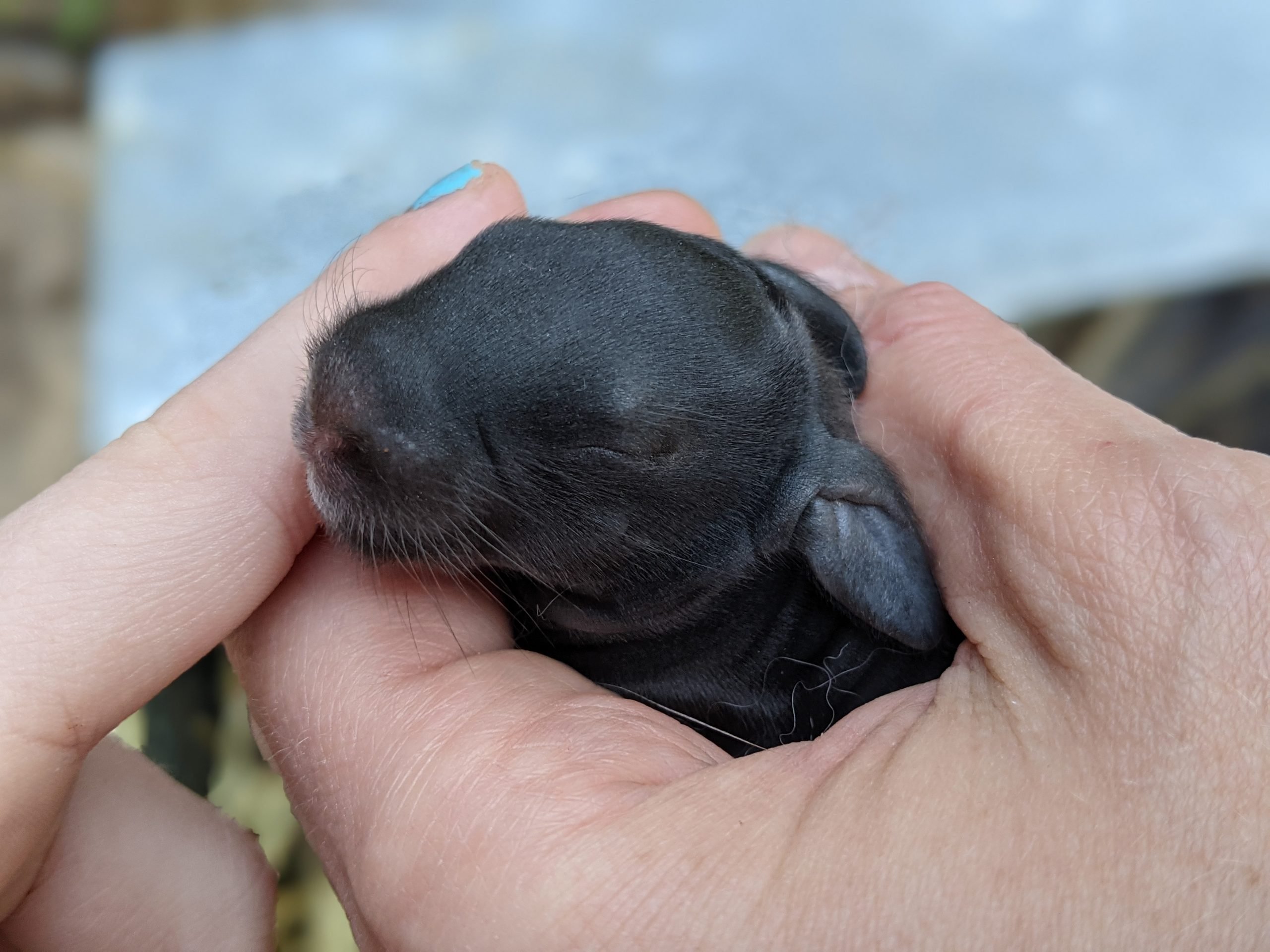
1. Place 2 nest boxes end to end
One scary scenario in rabbit kindling is when mama doe fails to use the nest box and kits are squirming all over the cage floor and even falling out the sides and squirming on the barn floor. Most experienced mama does have the good sense to use their nest box. It’s familiar to them. With first time rabbit mamas it’s hit or miss whether they will birth their kits in the nest box or some other corner of the cage. It’s almost always a corner –usually the darker back corners.
I have discovered that I can increase the chances that a new mama will use a nest box by filling both the back corners with nest boxes. Once she chooses one to make a nest in and kindles, I pull out the second nest box.
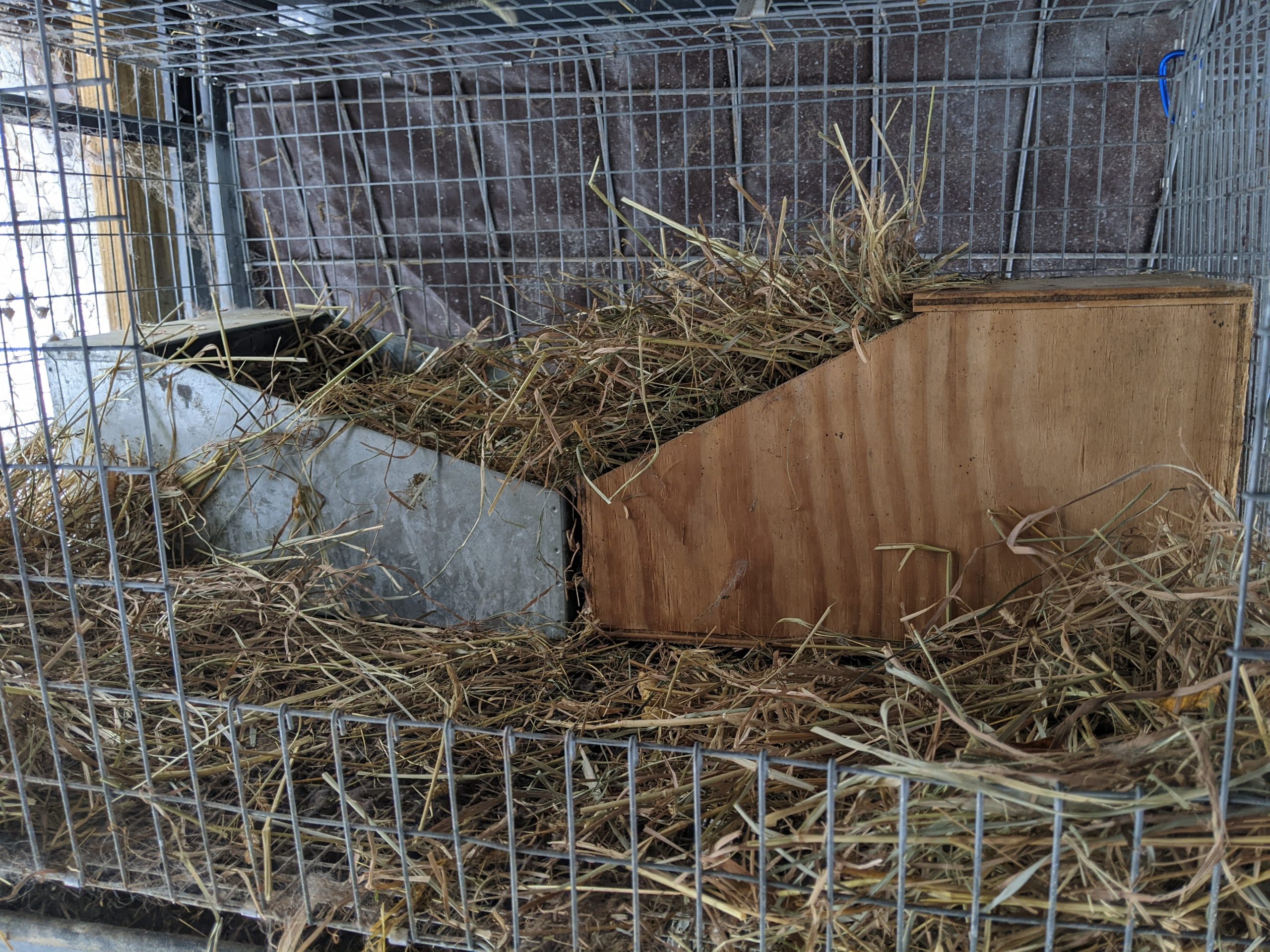
As a secondary line of protection, I like to put hay all around the remaining edges of the cage. That way if Mama Rabbit still chooses not use a nest box and makes a nest on the floor of the cage, there is a good chance the kits will stay together long enough for me to gather them up and place them in the nest box. Make a little hollow in the nest box for them and gather as much of the doe’s fur as possible to put in the nest with them.
We have a couple spare wooden nest boxes, but the best are these large nest boxes from Bass Equipment Company. They are easy to scrub clean after the kits leave the nest.
2. Shelving
A couple of times we have had reason to “shelve” litters of kits. Shelving is when you keep the nest box out of the mama’s cage except for feeding (nursing) time. The worst time we had to shelve was when we had a bad rat infestation around the barn and the rats ate some kits (newly out of the nest box) through the bottom bars of the cage. That was terrifying and awful. We shelved all the litters at night during that time and only brought them to the mamas to nurse during the day. The mamas were always very anxious to get in to nurse their babies when I brought them outside in the morning. It was fun to watch them.
After the first couple days the mamas were hopping into the nest boxes before I could get them all the way into the cage and the kits were hopping out trying to get to their mama. I was worried that someone was going to get hurt in all the confusion. I ended up carrying the kits and the box out to the barn separately. First, I slid the empty nest box into the cage and let mama jump in. And then I popped the kits in under her one by one in quick succession.
Other reasons for shelving include — extremely cold night time temperatures, mamas who won’t stop using the nest box as a litter box, and litter sharing. I have not had to do this, but litter sharing can be used if you have a second litter whose mama will not nurse them. You put one litter in during the day and one at night to try to have her nurse both of them. I find it much easier to foster the kits on a second or third doe, but it’s a good idea in case both mamas have huge litters and there’s no room to foster.



3. No summer breeding
I learned the hard way that Silver Fox mamas do not do well kindling in the heat of summer. I knew that it was a bad idea (hard on the mama and the kits), but I tried to squeak one more litter in due the first week of June. We ended up having a heat wave that week with temperatures going up to 92 degrees. She was an experienced doe. All the kits were in a nice nest in the box, but all were dead. Stillborn.
Does are more likely to be dehydrated, hemorrhage, kindle early, or have stillborns in the heat of summer. In our temperate Mid-Atlantic climate I only breed rabbits between September and April. We have not had any stillborn litters or dead mamas since I stopped breeding in the summer.
4. Cold comas

As I wrote in my post 7 Deadly Mistakes Folks Make When Raising Rabbits, “only warm kits can be pronounced dead”. Meaning that rabbit kits, who for various reasons become chilled at birth, go into a coma. If they are found and warmed up soon enough they will awaken and be fine healthy kits. We’ve done this successfully several times. It’s more magical than Sleeping Beauty, feeling them start to wiggle back to life.
If you find cold rabbit kits there are several ways to warm them up. My rabbit mentor told me to “pop ’em in my bra” for rewarming. Hehehe. An incubator, warming lamp, under a chick warmer plate, and warm lap have also all worked for us, though I think close to human skin is really the best.
5. Oats
For rabbits, as for humans, oatmeal is a good way to stimulate milk production. We give all of our lactating mama does as much pellet as they want and a handful of oats on top. They love the oats. My theory is that if the new mamas feel full of milk they are more likely to feed their kits in general and feed more frequently. I have not tracked this scientifically though.
You can use rolled or whole oats. The mamas like either one. There’s more waste with rolled oats as they fly away easier, but the kits can sample the rolled oats when they first start nibbling on the feed, whereas the whole oats are too big for them. Whole oats can be purchased in a 50 lb. bags from Tractor Supply inexpensively. It’s way more than you’ll need for a couple of litters though. And it will need to be stored carefully to keep bugs and pests out while you wait for the next litters. We tend to just use some of our “people food” rolled oats since we buy that in bulk as well.
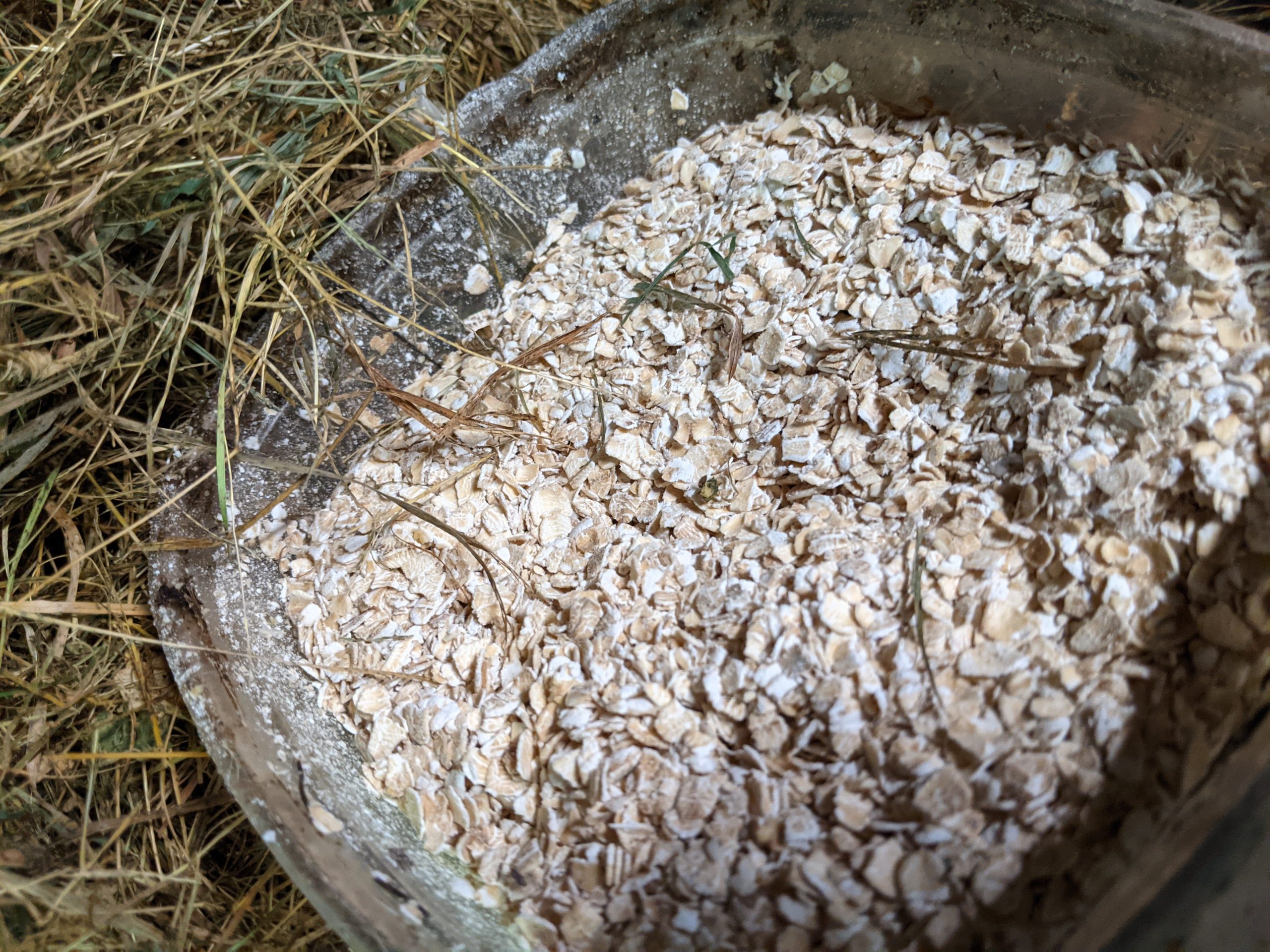
6. Filling the nest box
The nest box, especially in chilly winter months, needs to be properly filled to keep kits warm and cozy. Kiln dried wood chips or flakes (like they sell at tractor supply) work best as a base layer. [Note: Do NOT use cedar shavings for any kind of rabbit bedding]. The wood chips absorb moisture and help keep the upper layers of the nest dry. I like to put about 3 inches of wood chips in the bottom of the nest box. Then I stuff the rest of the space as full as possible with nice dry hay. Regular hay is perfect, alfalfa hay is not necessary. Straw would work in a pinch, but the mama does like to eat some of it, and they also will want to “mouth” the hay and carry it around until they feel the nest is just so.
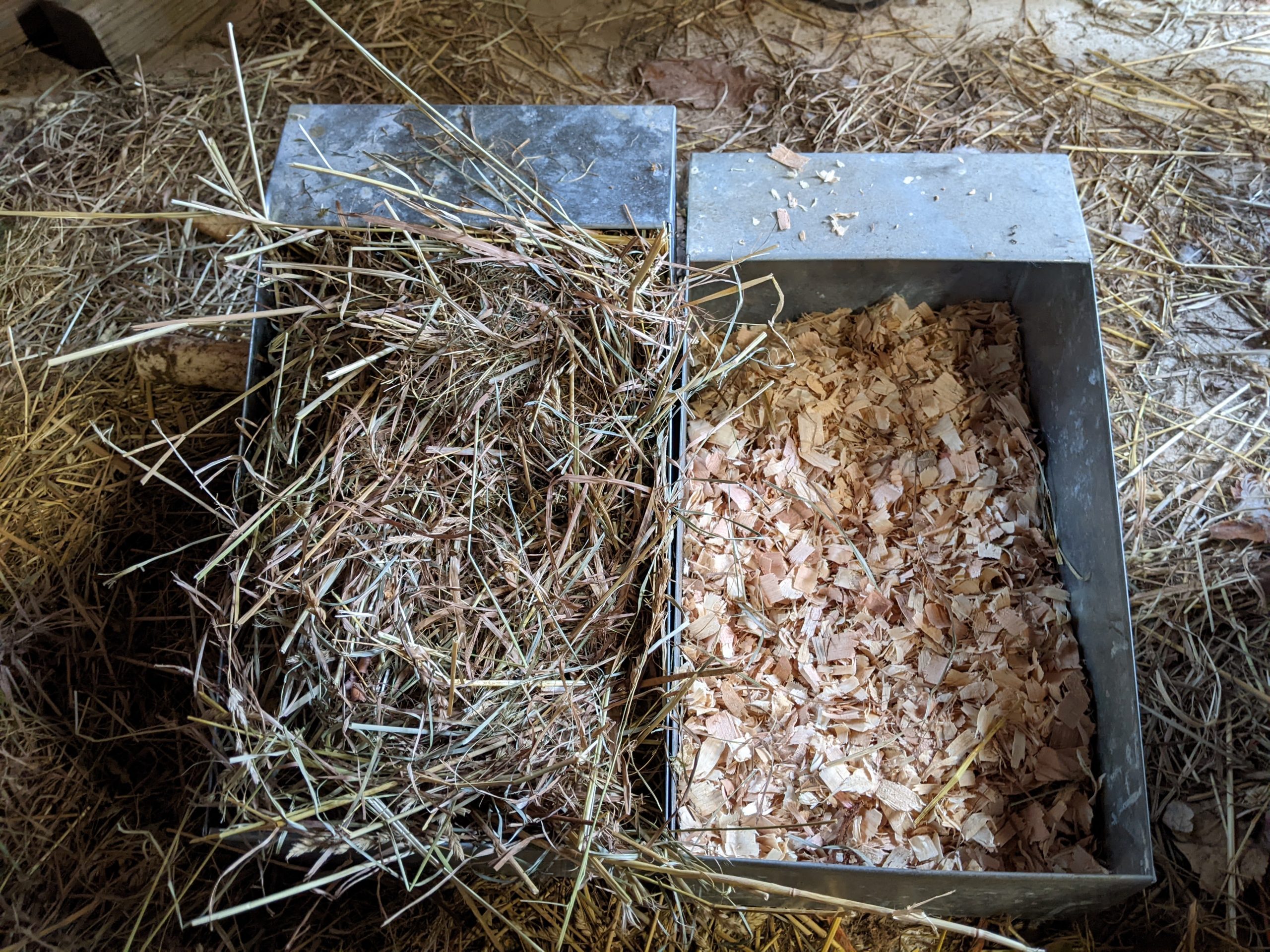
Nest boxes should be put into the cage about 4 days before a doe is expected to kindle. That gives her time to make her nest and get used to the box. Occasionally, a doe will decide that the nest box makes a nice litter box. In that case, change the bedding before the kits arrive. If she appears to be continuing to soil the nest box or if the nest materials become damp for another reason, change out all the bedding so the kits can stay warm and dry. Dampness is dangerous and likely to encourage the development of pathogens. If she still persists in soiling her nest box, shelving the box during the day or at night might be helpful. Thus far, we have not ever had to go to that extreme. I have had to completely change the nest box materials a few times. It’s easy to do as long as you have some supplemental fur around.
7. Supplemental fur on hand
Does pull fur from their bellies to line their nests. In the usual way of Mother Nature, removing fur from their bellies accomplishes multiple tasks:
1. It provides warm nest material for the kits until they can grow fur of their own.
2. It uncovers the doe’s nipples so that the kits can find them and nurse more easily.
Some mamas pull so much fur from their bellies that they denude themselves and have clouds of fur in the box and all over the cage too. Other mamas are not as conscientious or are more precise about how much is needed. They make a perfect little nest for their kits to snuggle in. No excesses of fur anywhere. Other mamas are a little skimpy and especially in winter could use a bit more padding OR they soil their nest box and the fur with it.
In those cases, it’s so helpful to have backup fur on hand. Extra fur allows you to change out soiled nest box materials and replace all the elements.

Collect excess fur sparingly from the corners of the cage and the nest boxes of mamas that have pulled out excessive amounts. Store it in a brown paper bag in case it is slightly damp and needs to breath/dry out.
NEVER use synthetic batting, wool batting, cotton balls, or other non rabbit materials in the nest box. First of all, they are not anywhere near as warm and breathable as the mama’s underfur. I tried to use some of those supplemental materials for one of our first litters. The mama did not pull any fur and it was quite chilly. One kit became tangled and strangled in the strands of material. It was a terrible learning experience. In a pinch, the only thing that I would recommend using other than rabbit fur is down feathers. I save some from duck and goose butchering days especially for adding to rabbit nests. It is the closest thing I know of to rabbit underfur and seems to be safe for them.
8. Back-up mamas
Always ALWAYS breed at least two does at the same time. This is especially true when breeding does for their first kindling. You never know whether a new mama doe is going to nurse well. She may not pull fur and or may not make a nest. She may become confused and then all those fragile little newborns will be scattered all over the cage floor (“on the wire” some people call it).
In my experience, if she has pulled fur and tried to make a nest (albeit in the wrong place) she will nurse her kits. That is best for her and the kits. In that case, gather up as much of the scattered fur as possible and add supplemental fur if needed. Make a fist sized hollow in the nest box, fill it with the fur and put the kits inside together. Leave them be with her for 24-48 hours and then check their bellies. Kits who are being fed have round bellies. See photo below.
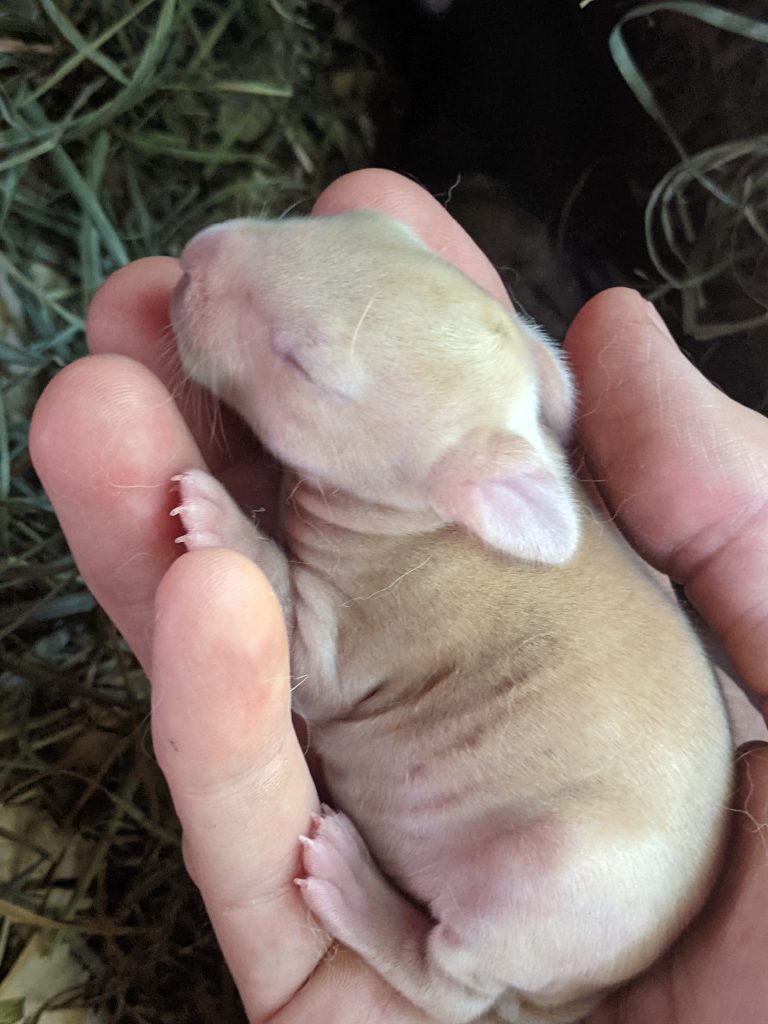
A first time mama who fails to nurse her kits here at our Mid-Atlantic Homestead always gets a second try. We rebreed her within a couple days and foster her hungry babies in with the second and third mama does who are nursing well. We give the foster mamas plenty of oats.
When I first started fostering kits into new nests I was terrified that the foster mama might attack them. We always rubbed a little vanilla on the foster mama’s face to help her not smell the difference. That worked fine. Since then I have learned that Silver Fox mamas at least, are not terribly picky about whose babies are in their nest. They will even nurse two litters if they must (see section on shelving). Nowadays I simply put the little foster kits down into the new nest and let them snuggle in. If they look a lot weaker than their counterparts, you can take out most of the original litter for one feeding (shelve them) and let the hungry ones get nice full bellies before they have to compete.
9. Only one kit or a big litter (more than 9 kits)
If there is only one kit that survived from a litter, you have a couple of options. When it’s warm (50F+) outside you could try to leave it alone in its furry nest and it might grow very fat from having all the mama’s love and attention to itself. However, it is hard for one lone kit to stay warm and I would recommend bringing over one or two kits from another big litter (born around the same time) and fostering them with the lone kit. If both of the litters from that breeding are small in number, then it would be wise to combine the litters with one mama and rebreed the other. Litter sizes tend to shrink as does get older (around 3-4 years old). That is when we retire them as breeders and let them enjoy some fresh pasture. Some folks might cull the mamas at that time, but I have never been able to bring myself to do that to a doe who has done her best for us for several years. Our old mama does are like pets. And they still nourish the ground with their excellent manure.
10. Cull the bad mamas
I hate to say it, but sometimes does are just bad mothers. Only twice have I culled Silver Fox does for bad mothering over 6 years and several hundred rabbits, but it certainly happens. I almost always give first time mama rabbits the benefit of the doubt. If they do not pull fur and nurse their babies on the first litter then I rebreed them right away and foster their babies on to another mama or two. Usually, by the second litter they get everything figured out and make a nice nest. One of my does failed to nurse even on the third try, and I had to cull her and eventually her whole genetic line. They just had bad mothering genes.
Silver Fox are generally friendly and docile, especially when they are handled regularly. I had one beautiful doe who became extremely feisty when pregnant, lunged at me, and when she kindled, she ate or mangled all of her kits. I did not give her a second chance. It was too gruesome to risk repeating and her overall temperament was terrible. Mean Silver Fox rabbits should be culled in my opinion. That is not to breed standard.




Leave a Reply